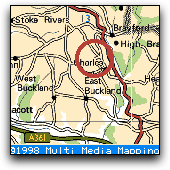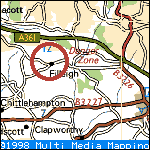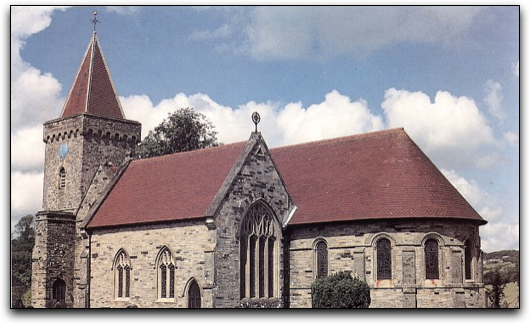
Charles

"A village & parish in the valley of the river BRAY, 6 miles N by W of South Molton contains 362 souls & 2432 acres of land including Brayford hamlet & a number of scattered houses. Sir Peregrine Fuller Palmer Acland, Bart. Is Lord of the Manor, & owner of a pleasant seat called 'Little Bray' in the valley, 2 miles N. Of the village. A great part of the parish belongs to Earl Fortesque, J Davey Esq., H. Karslake Esq., Jno. Loosemoore, Jno. Smythe & several smaller owners. The Church (St. John) has a tower & 5 bells & the living is a rectory valued in KB at £9.10 shillings & in 1831 at £160 in the patronage & incumbency of the Rev. Richard Blackmore. M.A. who has 130 acres of glebe, and a large & commodious 'Rectory House'" [From White's Devonshire Directory (1850)]
A parish in Shirlwell Hundred, the Archdeaconry of Barnstaple, and Diocese of Exeter, 9 miles E. of Barnstaple, which had 343 inhabitants in 1831. Brayford is part in this parish, part in High Bray.
A parish in Shirlwell Hundred, the Archdeaconry of Barnstaple, and Diocese of Exeter, 9 miles E. of Barnstaple, which had 343 inhabitants in 1831. Brayford is part in this parish, part in High Bray.
Filleigh

"BUCKLAND-FILLEIGH is a village and parish, 6 1/2 miles W.N.W. of Hatherleigh, containing 275 souls, and 3037 acres of land, nearly all the property of Lord Ashburton and Lord Clinton, the former of whom owns the manor of Buckland-Filleigh, and has a pleasant seat here, formerly the residence of the Filleigh and Fortescue families. Lord Clinton owns the manor and barton of Hartleigh, by inheritance from the Rolles. This estate includes part of Heanton deer park. The Church (St. Mary,) is a beautiful little structure, standing close to Lord Ashburton's mansion, and containing several handsome monuments of the Fortescue family." [From White's Devonshire Directory (1850)]
"FILLEIGH, a small village, pleasantly situated 3 1/2 miles W. of South Molton, and 8 miles E.S.E. of Barnstaple, has in its parish 395 souls, and 2200 acres of land, including about 826 acres in the large and finely wooded park of CASTLE HILL, the beautiful seat of Earl Fortescue, who has another seat at Ebrington Hall, Gloucestershire. The grounds, and the old mansion of Castle Hill, were much altered and improved about 1740, by Hugh Fortescue, Lord Clinton, who, in 1746, was created Earl Clinton and Baron Fortescue, and died without issue in 1751, when the earldom became extinct, but the Barony of Fortescue passed to his half-brother, Matthew Fortescue, who died in 1785, and was succeeded by his son, Hugh, who was created Earl Fortescue and Viscount Ebrington, in 1789. . . The large and handsome mansion of Castle Hill stands in the extensive park, on a well wooded eminence, whose summit is decorated with the artificial semblance of a ruined castle, and commands a prospect of very considerable extent. The grounds in front of the house are disposed into various pleasing slopes, which gradually descend from the terrace to a fine sheet of water, and are diversified by stately groves. Beyond the lake, the ground again rises, and the view is terminated by a handsome triumphal arch, on the top of the hill. Various other ornamental buildings are scattered through the park. In the shrubbery are some remarkably large Portugal laurels; and in the garden is a peach tree of uncommon dimensions." [From White's Devonshire Directory (1850)]
A parish in Braunton Hundred, the Archdeaconry of Barnstaple, and the Diocese of Exeter.
"FILLEIGH, a small village, pleasantly situated 3 1/2 miles W. of South Molton, and 8 miles E.S.E. of Barnstaple, has in its parish 395 souls, and 2200 acres of land, including about 826 acres in the large and finely wooded park of CASTLE HILL, the beautiful seat of Earl Fortescue, who has another seat at Ebrington Hall, Gloucestershire. The grounds, and the old mansion of Castle Hill, were much altered and improved about 1740, by Hugh Fortescue, Lord Clinton, who, in 1746, was created Earl Clinton and Baron Fortescue, and died without issue in 1751, when the earldom became extinct, but the Barony of Fortescue passed to his half-brother, Matthew Fortescue, who died in 1785, and was succeeded by his son, Hugh, who was created Earl Fortescue and Viscount Ebrington, in 1789. . . The large and handsome mansion of Castle Hill stands in the extensive park, on a well wooded eminence, whose summit is decorated with the artificial semblance of a ruined castle, and commands a prospect of very considerable extent. The grounds in front of the house are disposed into various pleasing slopes, which gradually descend from the terrace to a fine sheet of water, and are diversified by stately groves. Beyond the lake, the ground again rises, and the view is terminated by a handsome triumphal arch, on the top of the hill. Various other ornamental buildings are scattered through the park. In the shrubbery are some remarkably large Portugal laurels; and in the garden is a peach tree of uncommon dimensions." [From White's Devonshire Directory (1850)]
A parish in Braunton Hundred, the Archdeaconry of Barnstaple, and the Diocese of Exeter.
The Parish Church of St. Paul, Filleigh, Devon
There are many monuments in remembrance of the Fortesque family, both in the churchyard and inside the church.

